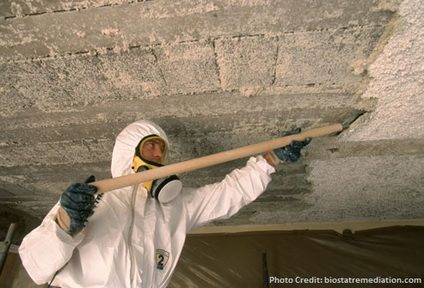
Mesothelioma is a particularly vicious form of lung cancer, brought on by exposure to asbestos.
It’s a terrible way to die, a terrible way to watch a loved one gradually lose their ability to draw breath.
It’s already the country’s leading cause of work-related death, killing more than 2,000 Canadians per year and more than 107,000 people around the world. And because it can take up to 50 years to develop, new cases are expected to accumulate for decades to come.
That’s why it was very good news when Prime Minister Justin Trudeau announced a long-awaited ban on asbestos. But it remains to be seen how quickly the ban will take effect, and how effectively it will deal with asbestos that is already present in buildings and a variety of products.
The Miracle Becomes a Nightmare
When it was first introduced, asbestos was seen as a miracle product, a sturdy, naturally-occurring fibrous material that could resist heat and flame. Canada, particularly Quebec, became a leading producer, responsible for 40% of the world’s chrysotile asbestos supply in 1966.
Asbestos is used in brake linings and pads, building materials, clothing, and fabricated products. While Canada’s asbestos exports have actually declined in recent years, the Globe and Mail reported earlier this year, imports hit a six-year high in 2015—$8.3 million worth of products, compared to $6 million in 2014.
But “over the past 100 years, medical evidence has proven again and again that asbestos causes many deadly diseases in humans,” the Sokolove Law blog noted. “One of the more lethal aspects of asbestos is that if a fibre is inhaled, it can seldom be removed from a victim’s lungs. Once inside the lungs, the rough fibres can horribly scar the inner tissue, a condition known as asbestosis. Mesothelioma, a rare and deadly form of cancer, is also caused exclusively by exposure to asbestos.”
And it isn’t just a job hazard: Canadians outside the workplace can be exposed in offices, schools, hospitals, community centres, even their homes. There are cases of people contracting mesothelioma after a renovation carried asbestos dust through building ventilation systems and into their lungs. Or of family members or other bystanders contracting mesothelioma after being exposed to fibres that had been brought home on worker's clothing.
So it makes sense that the World Health Organization has already declared all forms of asbestos highly carcinogenic. It’s been banned outright in 55 countries, including Britain, Australia, Japan, Sweden, Germany and Denmark.
Asbestos in Our Buildings
The biggest, widest risk comes from older buildings. The rule of thumb is that asbestos is usually safe if it’s undisturbed. But when a building is renovated or demolished, the exposed material becomes a lethal hazard to the people doing the work.
Sierra Club Canada Foundation has been hearing about one nightmare project in Toronto where an older building was just pulled down, with little or no thought to the clouds of asbestos dust and fibres that resulted. The building was located adjacent to a playground.
That kind of sordid tale makes an asbestos ban particularly important with the new government in Ottawa embarking on an ambitious and badly-needed plan to invest $60 billion in infrastructure over the next 10 years, beginning with $11.9 billion over the next five. It’s imperative to keep asbestos out of any new construction the government funds, but also to be exceptionally careful with any existing structures that are up for renovation.
“Given the huge investment that the federal government is going to make around infrastructure, this is the time to say ‘we’re not going to repeat past mistakes,’” Canadian Labour Congress (CLC) President Hassan Yussuff told the Globe and Mail.
From Attitude to Action
Trudeau’s announcement did mark a powerful departure from the government’s past position on asbestos.
As recently as 2014, the Globe was pointing to the federal government as a defender of an industry dominated by such notables as Koch Industries and Georgia-Pacific, according to the Sokolove blog. With British Columbia describing the material as a “hidden killer,” and a Saskatchewan government website warning that “inhaling asbestos fibres can cause chronic, irreversible, and life-threatening lung disease,” Ottawa led off its site by proclaiming that “asbestos was a popular material used widely in construction and many other industries.”
As the Globe editorial board asked: “See the difference?”
Health Canada’s website was revised in June 2015 to acknowledge that the substance can cause asbestosis and mesothelioma, and “greatly increase the risk” of lung cancer in smokers. Then in April 2016, Public Services and Procurement Minister Judy Foote declared a ban on asbestos products in new construction and renovation of federal buildings, following news reports that the material was still permitted in new government structures. “We have heard the concerns expressed by Canadians over the continued use of asbestos,” Foote told CBC.
On April 28, the National Day of Mourning for workers who’ve been killed or injured on the job was all about asbestos, the first time the annual commemoration had been devoted to a single workplace hazard. In a news conference that day, the CLC called for a legislated ban on asbestos imports and exports, a national registry of public buildings containing asbestos, and a national registry of workers diagnosed with asbestos-related diseases.
It remains to be seen how detailed the registries will be, how effectively asbestos in existing buildings will be managed and controlled, and what standards will apply to the removal process, and the safety training and equipment available to workers.
So while it’s tremendously important that the Prime Minister has announced an asbestos ban, the timing and details will matter. SCCF will be keeping a close eye on this issue, and you should be, too.
Sincerely,
Diane Beckett
Interim Executive Director
Sierra Club Canada Foundation
One Earth • One Chance
Like us on Facebook.
Find us on Twitter @sierraclubcan.
SCCF's success depends on the support of like-minded individuals and organizations.
